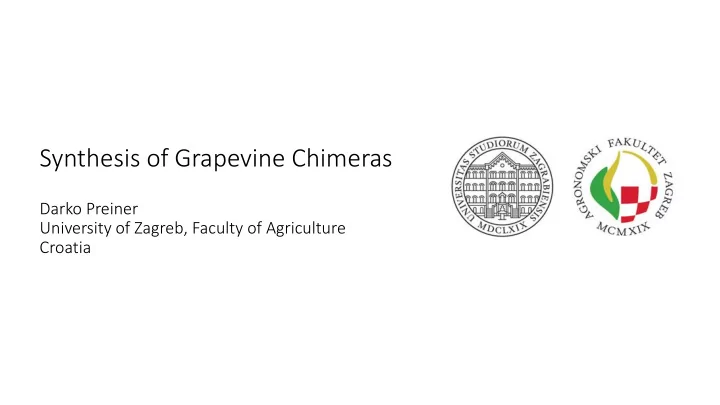

Synthesis of Grapevine Chimeras Darko Preiner University of Zagreb, Faculty of Agriculture Croatia
Project: Developement of Grapevine Synthetic Chimeras • Funded by: Croatian Science foundation - Starting grant • Supported by: University of Zagreb, Faculty of Agriculture • Darko Preiner, Zvjezdana Marković, Iva Šikuten , Anita Bošnjak Mihovilović, Jasminka Karoglan Kontić, Edi Maletić, Željko Andabaka, Domagoj Stupić, Maja Žulj Mihaljević
Plant chimeras • plants which contain tissues of at least two genotypes in different cell layers • Tunica-corpus model – higher plants have 2 or 3 cell layers in apical meristem • Cells in the outermost layer(s) divide only anticlinally • Cell layers of apical meristem preserve their integrity - future organs and tissues • Grapevine – (in most cases) two layers - L1 i L2 • L1 – epidermal tissue (leaf, berry…) • L2 - other tissues – inner part of leaf, berries, adventive roots…
Types of chimeras Margaret H. Frank, Daniel H. Chitwood, Plant chimeras: The good, the bad, and the ‘ Bizzaria ’, Developmental Biology, Volume 419, Issue 1, 2016, Pages 41-53,
Grapevine chimeras • Manny cultivars (clones) are chimeras – mutations in one of the cell layers • Pinot gris, Pinot meunier, some Chardonnay clones, Plavac mali sivi • They can be separated using somatic embryogenesis • Eg. - npr. Pixie ( dvarf vine, microvine ) L1 layer mutation from Pinot meunier Pelsy, F. (2010). Molecular and cellular mechanisms of diversity within grapevine varieties. Heredity , 104 (4), 331-340.
Synthetic chimeras – chimeral breeding • Developed from two different genotypes • Cultivars (or even species) • Different methods used: • Graft-chimeras - Adventive shoots from mixed callus developed after grafting - in-vivo • Known samples of graft-chimeras.: • Citrus medica i C. aurantium; - Bizzaria • Laburnum anagyroides i Cytisus purpureus; • Crataegus monogyna i Mespilus germanica; • Cassava (Manihot esculenta + Manihot fortalezensis) • In-vitro - Shoots developed from callus after micrografting or contact cultivation of two genotypes
Only one reseach in case of grapevine • Verdisson (1998., 1999.) – Champagne (France) – Chardonnay + Pinot noir • In-vitro – mixed callus from grafted nodal and internodal segments – organogenesis – no results preserved (personal communication)
Potential for grapevine breeding • Alternative method for grapevine breeding • Combination of existing genotypes • Resistant genotype as protection for non- resistant • „hand in glove”
Our approach • In – vitro Meristematic Bulk Tissue - MBT (Mezzeti i sur. 2002.) grafting • High regeneration capacity of MBT • (Alternative for somatic embryogenesis for genetic transformation) • Development of mixed MBT from two genotypes • Regeneration of plants
Detection of chimeral plants • Phenotyping • Genotyping – SSR markers • Detection and quantification
Results • Cabernet sauvignon + Babić • 118 plants regenerated grafted MBT • 6 plants with different types of mosaics on leaves – heterogenic phenotype • 15 plants corresponding to Babić’s phenotype • Others Cabernet sauvignon • Cabernet sauvignon + Chardonnay - 142 plants regenerated - All plants with uniform phenotype corresponding to Chardonnay
Results • Cabernet sauvignon + Babić • 6 plants with heterogenic phenotype – SSR profile of both genotype detected • 1 additional plant with uniform phenotype displayed profile of both genotypes. • Cabernet sauvignon + Chardonnay - Only one plant displayed profile of both genotypes - Uniform phenotype
Field evaluation in prgress
MBT grafting shows promising results in development of grapevine synthetic chimeras Conclusion Ongoing research • Interspecific chimeras development (Vitis vinifera + other Vitis sp.) • Stability and organization of chimeras • Reorganization of sectorial to periclinal chimeras
Thank you for your attention
Recommend
More recommend